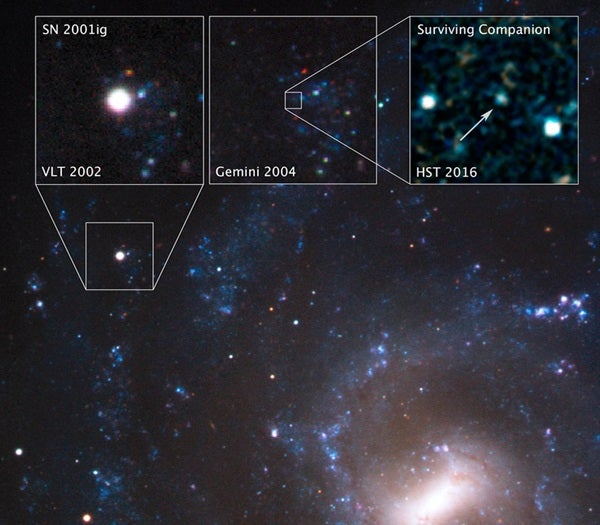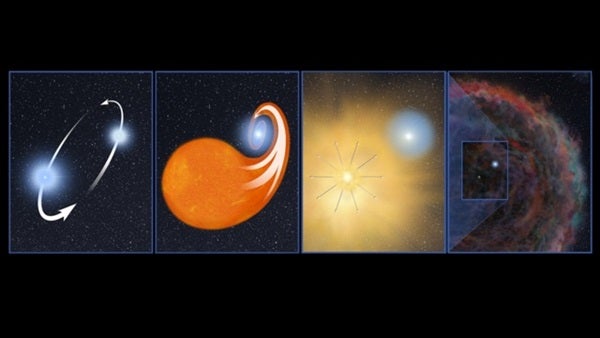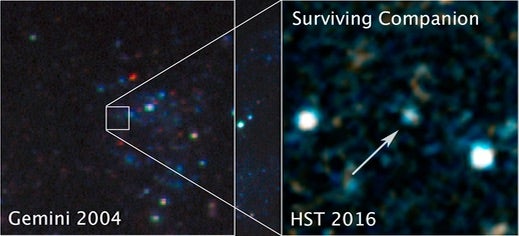The image of the companion star, which was seen in the fading afterglow of a supernova that exploded some 40 million light-years away in the galaxy NGC 7424, provides the most compelling evidence yet that some supernovae originate in double-star systems. Furthermore, according to the study, the supernova’s companion star was not just an innocent bystander to the explosion. Instead, it was most likely the instigator.
The supernova in question, SN 2001ig, is considered a Type IIb stripped-envelope supernova. This unusual type of supernova occurs when the majority of a massive star’s hydrogen is stripped away prior to exploding. In 1987, astronomer Alex Filippenko from the University of California, Berkeley, became the first person to identify this rare breed of supernovae. And since then, astronomers have struggled to explain exactly how stripped-envelope supernovae actually lose their outer envelopes.
Originally, astronomers believed that the progenitor stars to these supernovae lost their outer shells due to incredibly strong and fast stellar winds. However, this theory seems to be incomplete, as observers have not found enough progenitor stars to make it the only feasible scenario. “That was especially bizarre, because astronomers expected that they would be the most massive and the brightest progenitor stars,” said co-author Ori Fox, an astronomer at the Space Telescope Science Institute in Baltimore, in a press release. “Also, the sheer number of stripped-envelope supernovas is greater than predicted.”
This discrepancy between prediction and observation led astronomers to posit that Type IIb stripped-envelope supernovae may instead be a result of co-orbiting pairs of binary stars. “We know that the majority of massive stars are in binary pairs,” said lead author Stuart Ryder, an astronomer at the Australian Astronomical Observatory (AAO) in Sydney. “Many of these binary pairs will interact and transfer gas from one star to the other when their orbits bring them close together.”
In the case of SN 2001ig, the companion star is believed to have siphoned off nearly all of the hydrogen from the outer shell of the supernova’s progenitor. Since the outer region of a star is extremely efficient at transferring energy from the core outward, the absence of an envelope can have dramatic implications. Specifically, over the course of millions of years, the companion star robbed so much material from the primary star’s envelope that it created an instability. This ultimately caused the progenitor star to periodically expel massive shells of hydrogen gas, priming it for an epic explosion.
With the exact coordinates of the potential supernova companion in hand, the team waited patiently (for about a decade) while the supernova’s glow continued to fade away. The team then observed the suspected companion with the all-powerful Hubble Space Telescope, which ultimately captured the groundbreaking image below. “We were finally able to catch the stellar thief, confirming our suspicions that one had to be there,” said Filippenko.
With this new image, astronomers have finally proven that at least some stripped-envelope supernovae have companions, but now their goal shifts to determining exactly how many. To help answer that question, the team plans to focus their search on supernovae that have lost their entire envelopes long before they explode. Without any surrounding gas for the supernova’s shock wave to crash into, the team hopes they will only have to wait a few years for the debris to clear, allowing them to quickly search for surviving companions.
So who knows, Hubble may be able to snap another photo of a surviving companion by its 30th birthday. And if not, the James Webb Space Telescope, now scheduled for launch in 2020, will surely give it a go.












